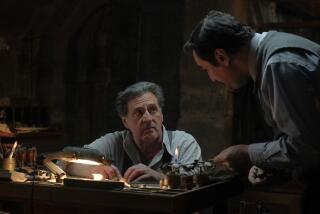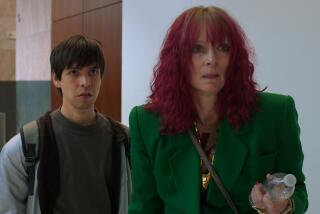Review: Art doc ‘Julian Schnabel: A Private Portrait’ fawns rather than make the deep dive
Actors, fellow artists and filmmakers, children and former wives — everyone Pappi Corsicato interviewed for his new documentary, “Julian Schnabel: A Private Portrait,” has come to praise the man, not to bury him.
In reasonable doses, there’s nothing wrong with praise, and in the case of Schnabel, it’s a kind of corrective; he’s an art-world superstar whose commercial success has made him a lightning rod for detractors’ scorn. As one interviewee puts it, “It was wrong to like Julian Schnabel in the ’90s.” But rather than explore his place in the arts and balance all that adoration with insight, Corsicato opts for hero worship. The result is a visually exciting but emotionally monotonous film.
The excitement lies in the footage, both new and from the archives, of Schnabel at work, truly hands-on and fully engaged with the textures and colors of his paints. With one exception, he’s always solo. In pointed contrast, his contemporary Jeff Koons is interviewed in a studio where a crew of apprentices work busily on canvases that will bear his name.
Within the admiring testimony of Schnabel’s friends and family, the phrase repeated most often is “larger than life.” Going big comes naturally to the artist, from his oversize canvases to his towering pink palazzo in Greenwich Village (predictably, there’s no mention of protesting neighbors or charges of circumvented zoning laws). Corsicato traces the formative arc of a magnetic, life-loving personality and, above all, a clear sense of purpose. It begins with Schnabel’s special treatment as an infant (noted by his sister) and moves through his teen years as a Texas surfer, his Jewish family having made the unlikely move from Brooklyn to Brownsville.
We’ve perhaps come to expect a degree of torment in artists’ stories. With self-doubt and struggle nowhere to be found in this one, it’s either a striking rebuttal to a stereotype or a glossed-over narrative. There’s a fleeting nod to lean years as an up-and-comer, but mainly Corsicato lays out a trajectory of seemingly unbridled success. There isn’t the slightest hint of rivalry, either, in this glimpse of the highly competitive art scene. To the contrary, Koons points out Schnabel’s generosity in opening doors for other artists.
Shifting to his subject’s work as a notable filmmaker, Corsicato offers a few illuminating perspectives on Schnabel’s working methods — particularly for “The Diving Bell and the Butterfly” — and his fondness for including his children in his projects. But there are no indelible behind-the-scenes anecdotes. It’s almost as if the laudatory chorus grows less incisive the starrier it is; however thoughtful and heartfelt the comments of Willem Dafoe, Mathieu Amalric, Al Pacino and Anne Consigny, in combination with the film’s other talking heads their observations take on the feel of publicity material, elegant additions to the director’s breathless homage.
Through Schnabel’s friendships with other artists, notably Lou Reed and Jean-Michel Basquiat, Corsicato reaches toward something deeper and finds dark glimmers of it in a couple of brief but stirring reflections from Schnabel (who, it should be noted, serves as an executive producer of the film). Rather than digging beneath the surface, though, the director turns to the ubiquitous Bono to characterize Schnabel’s bond with Reed (Reed’s widow, Laurie Anderson, appears as well). More helpfully, Corsicato uses excerpts from Schnabel’s fluent feature debut, “Basquiat,” a movie in which artistic mastery and personal connection to the subject came together beautifully. Unlike Corsicato’s documentary, it didn’t turn love and admiration into hagiography.
The doc is bookended with scenes of Schnabel and his youngest son, an infant at the time, on one of Italy’s Li Galli Islands. The artist’s pride and delight are evident, and it’s easy to connect these tender, playful moments with his exuberance for making art. Here, as with well-chosen footage of him at work, the boldness and conviction that so much of the film merely discusses take dynamic form. Off the Amalfi Coast, cameras capture Schnabel, still a surfer, in a high dive into the Mediterranean. By comparison, this “Private Portrait” of a larger-than-life figure prefers to tread water.
-------------
‘Julian Schnabel: A Private Portrait’
Not rated
Running time: 1 hour, 28 minutes
Playing: Laemmle Monica Film Center, Santa Monica
See the most-read stories in Entertainment this hour »
Movie Trailers
More to Read
Only good movies
Get the Indie Focus newsletter, Mark Olsen's weekly guide to the world of cinema.
You may occasionally receive promotional content from the Los Angeles Times.






